Grouse
| Grouse Temporal range: Early Miocene to recent
| |
|---|---|
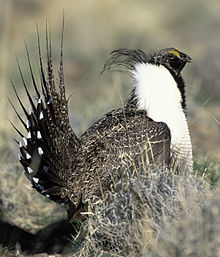
| |
| Male sage grouse Centrocercus urophasianus | |
| Scientific classification | |
| Domain: | Eukaryota |
| Kingdom: | Animalia |
| Phylum: | Chordata |
| Class: | Aves |
| Order: | Galliformes |
| Family: | Phasianidae |
| Subfamily: | Phasianinae |
| Tribe: | Tetraonini Leach, 1819 |
Genera
| |
|
and see text | |
| Synonyms | |
|
Tetraonidae Vigors, 1825 | |

Grouse
Grouse inhabit
The
Description
Like many other Galliformes, grouse are generally heavily-built birds. The traditional grouse (excluding turkeys) range in length from 31 to 95 cm (12 to 37+1⁄2 in), and in weight from 0.3 to 6.5 kg (3⁄4 to 14+1⁄4 lb). However, if they are included,
Feeding and habits
These birds feed mainly on vegetation—buds,
Forest species flock only in autumn and winter, though individuals tolerate each other when they meet. Prairie species are more social, and tundra species (ptarmigans, Lagopus) are the most social, forming flocks of up to 100 in winter. All grouse spend most of their time on the ground, though when alarmed, they may take off in a flurry and go into a long glide.[8]
Most species stay within their breeding range all year, but make short seasonal movements; many individuals of the
Reproduction
In all but one species (the
The nest is a shallow depression or
Populations
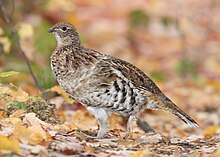
Grouse make up a considerable part of the vertebrate biomass in the Arctic and Subarctic. Their numbers may fall sharply in years of bad weather or high predator populations—significant grouse populations are a major food source for lynx, foxes, martens, and birds of prey. However, because of their large clutches, they can recover quickly.[citation needed]
The three tundra species have maintained their former numbers. The prairie and forest species have declined greatly because of habitat loss, though popular game birds such as the
Sexual size dimorphism
Male size selection
The phenotypic difference between males and females is called sexual dimorphism.[9] Male grouse tend to be larger than female grouse,[9] which seems to hold true across all the species of grouse, with some difference within each species in terms of how drastic the size difference is.[9] The hypothesis with the most supporting evidence for the evolution of sexual dimorphism in grouse is sexual selection.[9] Sexual selection favors large males; stronger selection for larger size in males leads to greater size dimorphism.[9] Female size will increase correspondingly as male size increases, and this is due to heredity (but not to the extent of the male size).[9] This is because females that are smaller will still be able to reproduce without a substantial disadvantage, but this is not the case with males.[9] The largest among the male grouse (commonly dubbed 'Biggrouse') attract the greatest numbers of females during their mating seasons.[citation needed]
Mating behavior selection
Male grouse display lekking behavior, which is when many males come together in one area and put on displays to attract females.[15] Females selectively choose among the males present for traits they find more appealing.[15] Male grouse exhibit two types: typical lekking and exploded lekking.[9] In typical lekking, males display in small areas defending a limited territory, and in exploded lekking, displaying males are covered over an expansive land area and share larger territories.[9] Male grouse can also compete with one another for access to female grouse through territoriality, in which a male defends a territory which has resources that females need, like food and nest sites.[9] These differences in male behavior in mating systems account for the evolution of body size in grouse.[9] Males of territorial species were smaller than those of exploded lekking species, and males of typical lekking species were the largest overall.[9] The male birds that exhibit lekking behavior, and have to compete with other males for females to choose them, have greater sexual dimorphism in size.[16] This suggests the hypothesis of sexual selection affecting male body size and also gives an explanation for why some species of grouse have a more drastic difference between male and female body size than others.[citation needed]
Contrast with other bird species
Sexual size dimorphism can manifest itself differently between grouse and other birds. In some cases, the female is dominant over the male in breeding behavior, which can result in females that are larger than the males.[17]
In culture
Grouse are
Species
Extant genera
| Image | Genus | Extant Species |
|---|---|---|

|
Pucrasia – koklass pheasant[note 1] |
|

|
Meleagris – turkeys[note 1] |
|
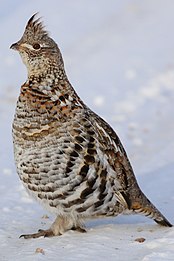
|
Bonasa – ruffed grouse |
|
 |
Canachites – spruce grouse |
|
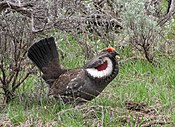
|
Dendragapus – blue grouse |
|

|
Centrocercus – sage grouse |
|
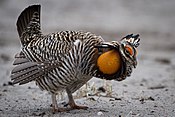
|
Tympanuchus – prairie grouse |
|

|
Tetrastes – hazel grouse |
|

|
Lagopus – ptarmigans |
|
 |
Falcipennis – Siberian grouse |
|
 |
Tetrao – capercaillies |
|
 |
Lyrurus – black grouse |
|
Extinct genera
- Genus †Proagriocharis
- Genus †Rhegminornis
References
Footnotes
- ^ S2CID 231963063.
- ^ S2CID 85807603. Archived from the original(PDF) on 2015-03-27.
- ^ "AOU Checklist of North and Middle American Birds". American Ornithologists' Union. Retrieved 2014-03-13.
- ^ "Tetraoninae". Integrated Taxonomic Information System. Retrieved 2013-03-13.
- ^ "Taxonomic Updates – IOC World Bird List". Retrieved 2021-08-01.
- ^ a b Boyd, John. "Phasianidae: Turkeys, Grouse, Pheasants, Partridges". Aves – A taxonomy in flux. Retrieved 2014-03-13.
- ISBN 978-1-85391-186-6.
- ^ ISBN 978-1-55297-777-4.
- ^ S2CID 6144117.
- ^ a b "turkeys, grouse, pheasants, and partridges articles-Encyclopedia of Life". Encyclopedia of Life. 27 April 2013. Retrieved 27 August 2023.
- ^ "Phasianidae Horsfield, 1821". GBIF. Retrieved 27 August 2023.
- PMID 26879712.
- ^ "Turkey Description, Habitat, & Facts". Encyclopedia Britannica. 4 May 1999. Retrieved 27 August 2023.
- ^ "Turkey Records - The National Wild Turkey Federation". -. Retrieved 27 August 2023.
- ^ .
- ^ Soulsbury, Carl D; Kervinen, Matti; Lebigre, Christophe (2014). "Sexual size dimorphism and the strength of sexual selection in mammals and birds". Evolutionary Ecology Research. 16: 63–76.
- The Wilson Bulletin. 98 (3): 387–406.
- ^ Larry D. Martin; James Tate, Jr. (1970). "A new turkey from the Pliocene of Nebraska"
- ^ Storrs L. Olson; John Farrand, Jr. (1974). "Rhegminornis restudies: a tiny Miocene turkey"
- ^ "BioLib: Biological library".
Notes
General
- De Juana, E. (1994). "Family Tetraonidae (Grouse)". In del Hoyo, J.; Elliott, A.; Sargatal, J. (eds.). Handbook of the Birds of the World, Vol. 2. New World Vultures to Guineafowl. Barcelona: ISBN 978-84-87334-15-3.
- "What Do Grouse Eat?". The Upland Hunter. 1 September 2017.
External links
- Grouse videos on the Internet Bird Collection
- Johnsgard, P. (1982). "Etho-Ecological Apects of Hybridization in the Tetraonidae". World Pheasant Association Journal. VII: 42–57.
- . New International Encyclopedia. 1905.


